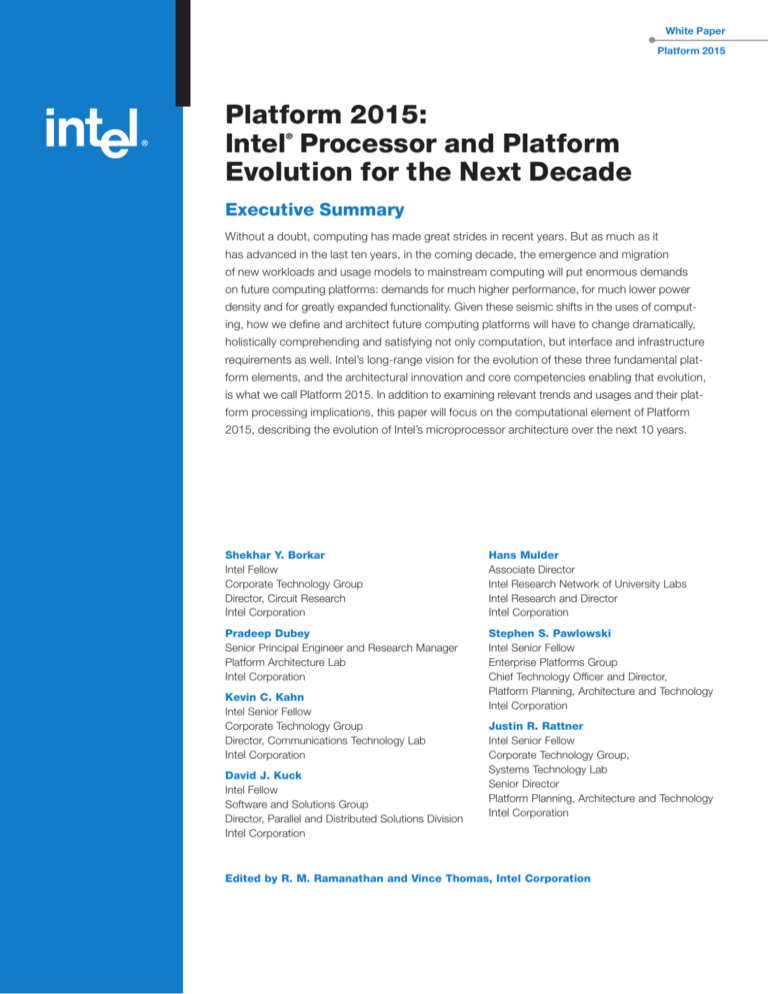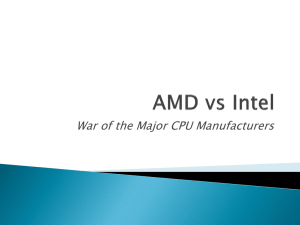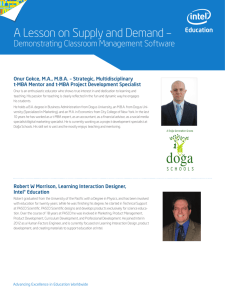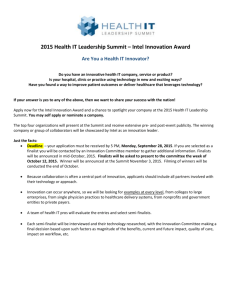
White Paper
Platform 2015
Platform 2015:
Intel Processor and Platform
Evolution for the Next Decade
®
Executive Summary
Without a doubt, computing has made great strides in recent years. But as much as it
has advanced in the last ten years, in the coming decade, the emergence and migration
of new workloads and usage models to mainstream computing will put enormous demands
on future computing platforms: demands for much higher performance, for much lower power
density and for greatly expanded functionality. Given these seismic shifts in the uses of computing, how we define and architect future computing platforms will have to change dramatically,
holistically comprehending and satisfying not only computation, but interface and infrastructure
requirements as well. Intel’s long-range vision for the evolution of these three fundamental platform elements, and the architectural innovation and core competencies enabling that evolution,
is what we call Platform 2015. In addition to examining relevant trends and usages and their platform processing implications, this paper will focus on the computational element of Platform
2015, describing the evolution of Intel’s microprocessor architecture over the next 10 years.
Shekhar Y. Borkar
Intel Fellow
Corporate Technology Group
Director, Circuit Research
Intel Corporation
Hans Mulder
Associate Director
Intel Research Network of University Labs
Intel Research and Director
Intel Corporation
Pradeep Dubey
Senior Principal Engineer and Research Manager
Platform Architecture Lab
Intel Corporation
Stephen S. Pawlowski
Intel Senior Fellow
Enterprise Platforms Group
Chief Technology Officer and Director,
Platform Planning, Architecture and Technology
Intel Corporation
Kevin C. Kahn
Intel Senior Fellow
Corporate Technology Group
Director, Communications Technology Lab
Intel Corporation
David J. Kuck
Intel Fellow
Software and Solutions Group
Director, Parallel and Distributed Solutions Division
Intel Corporation
Justin R. Rattner
Intel Senior Fellow
Corporate Technology Group,
Systems Technology Lab
Senior Director
Platform Planning, Architecture and Technology
Intel Corporation
Edited by R. M. Ramanathan and Vince Thomas, Intel Corporation
Contents
Introduction .......................................................3
Macro Trends .....................................................3
Processing Implications on Converged Platforms ...........5
Microprocessor Architecture in 2015:
The Intel Roadmap ............................................. 6
Meeting the Challenges ........................................ 9
Conclusion ......................................................11
References ......................................................12
2
Introduction
Macro Trends
The microprocessor is on the verge of undergoing perhaps
Processors and platforms of 2015 will be a direct outgrowth
the most significant transformation since its creation requiring
and response to social and technological trends already
advances in addition to achieving the predictions of Moore’s
evident today. Examples of these trends include:
Law. Continuing increases in transistor count are vital, of
rethinking of basic foundations such as process technology,
Pervasive Connectivity
and Proactive Computing
architecture and software. In fact, that rethinking is already in
Omnipresent connectivity is becoming a fact of daily life.
progress; the foundations for the next decade are even now
There are more than 1.4 billion mobile phone subscribers in the
being laid. And from these beginnings we can start to anticipate
world today – more than 20 percent of the world’s population.
what processors will look like ten years down the road. We will
Increasingly, people expect anytime, anywhere access to infor-
provide a glimpse of that future, describing microprocessor
mation, services and entertainment. That expectation is driving
architecture over the next 10 years, the trends and the applica-
a profusion of wireless mobile devices: notebooks, handhelds,
tions driving this outcome and the technical challenges that
“wearable” systems and other go-anywhere gadgets. Likewise,
only a very few companies are equipped to address.
“implicit” (i.e., embedded) computing is increasingly common-
course, but the next leap is also going to take some thorough
place, with processing carried out invisibly in all kinds of products
As demonstrated throughout Intel’s history of processor and
and environments: appliances, cars, buildings, toys – even the
platform innovation, this is an evolutionary approach in which
human body (via medical implants). At the same time, comput-
Intel integrates new features into our chips to bring more per-
ing is becoming more proactive – capable of automatically
formance and capabilities to the platform while maintaining
anticipating, adapting to and serving the needs of users.
compatibility with thousands of already existing applications
Corporations are already piloting networks of wireless sensor
and support for the ecosystem surrounding them.
chips to better manage everything from factories to vineyards,
and provide new kinds of healthcare services. And computers
are evolving towards more natural interfaces such as speech,
handwriting and image recognition.
Many-core Era
Massively parallel
applications
100
Increasing HW
Threads
Per Socket
Multi-core Era
Scalar and
parallel applications
10
HT
1
2003
2005
2007
2009
2011
2013
Figure 1: Current and expected eras of Intel® processor architectures
3
Ubiquitous device-to-device connectivity and proactivity
tion. These RMS workloads, when applied to the massive data
require that devices receive and handle a huge variety of data
streams that are becoming commonplace, will require super-
from a vast array of sources. Consequently, data will have to
computer-level performance in ordinary servers, PCs, and
be self-describing – containing not only the information to be
even compact mobile devices and embedded systems.3
processed, but also the descriptive “meta data” needed to interpret and process it correctly. For example, imagine a camera
that automatically aggregates information related to location,
environment, time, and the activities happening in its vicinity –
builds the context relevant to a picture/video-frame and builds
the “meta data” part of that picture/video-frame itself. With this
approach, a video camera in a gas station could issue an alert
of a potential theft in real time. Today’s computing devices lack
the computational power to perform these tasks in a cost
effective way. Computing devices must be developed that continuously learn and aggregate information relevant to the data
objects they work on. These machines will need enormous
This level of performance enables unimaginable new applications on desktop and mobile devices. These applications will
exploit the tremendous processing power of these future
platforms as well as their ability to access data anywhere in
the world. Some of the examples will include applications like
real-time decision-making analysis, intelligent search, real-time
virtual rich media and photorealism, interactive story nets,
multi-party real-time collaboration in movies, games and
strategy simulation and real-time medical imaging.
Internet as Computer and Conduit
processing power and memory in order to learn on their own,
While the Internet will continue to function as a communication
behave intelligently and become more and more proactive.
pipeline, it will also become smarter, grow substantially in bandwidth, and deliver larger and larger amounts of intelligent data
For instance statistical modeling methods like Bayesian networks
could be efficiently used to calculate posterior probabilities and
decision support systems could be developed based on those
probabilistic relations. Machine learning technologies based on
such mathematical principles along with increased processing
power could further enhance several applications such as
medical diagnostics, genomics, audio-visual processing
and detection, and analysis and testing of models.1
and applications to connected devices (thus adding to the
performance demands to process and search this data as
described above). The number and variety of these devices will
snowball, as a multitude of new implicit systems and sensor
nets come online. In order to provide access to rural users in the
developing world, the Internet will need to support new forms of
device connectivity and mechanisms for delay tolerance (due to
the unreliability of the connections) and transcoding (converting
content to a form appropriate to various devices). These new
Data Growth and
High-Performance Computing
Internet-connected devices will eventually number in the tens
Pervasive connectivity and proactive computing is leading to
same time, the Internet will increasingly serve as a kind of global
a tremendous increase in the amount of data used by individu-
computing platform, providing the connectivity to a vast array
als and organizations. The amount of data is doubling every
of new services and applications.4 This will require a massive
18-24 months as a result.2 That data must be transmitted,
infusion of processing power around the world to support the
stored, organized, and processed in real-time to be made use-
computing requirements of these new services and will be de-
ful. Today we have gigabytes of photos, music, text and video
livered in several forms including new and more powerful servers.
of billions, driving data traffic to mind-boggling levels. At the
on our systems being processed by gigahertz platforms. Soon,
our systems will host terabytes of digital data, requiring teraflops
and TIPS (trillions of floating point operations and trillions of
instructions per second) of performance.
Globalization
The Internet, high-speed data communication, and increasing
wireless connectivity are bringing the world together into a
These levels of performance will enable everyday use of new
corporate and consumer global village. Work teams, commerce
types of workloads and applications. One such workload is
and social exchange are increasingly spread across disparate
called “RMS” (recognition, mining, synthesis) and is made up of:
geographies, cultures and languages. As people and organiza-
1) the ability to recognize and model information of interest to
tions worldwide collaborate and interact more closely together,
a user or application on an ongoing basis; 2) the ability to mine
they will increasingly rely on computation to help them bridge
large amounts of real-world data in real-time for the information;
those gaps. Imagine, for example, headsets that perform real-
and 3) the ability to synthesize large datasets or a virtual world
time language translation. Globalization also drives the need
scenario, interactively and in real-time, based on the informa-
for new form factors, price points and intelligent interfaces –
4
computers are impractical, too expensive or too complex.
Special-purpose Performance
and Adaptability
For example, new performance rich, low power and low cost
Many of these future applications and usage models will require
mobile devices have been envisioned for rural populations in
special types of processing in addition to high-performance,
the developing world with variable literacy rates and limited
general-purpose computation. Future processors will need fast
access to reliable power grids and networks.
on-chip circuitry for specialized functions such as media pro-
to reach a greater range of users for whom conventional
cessing, new user interfaces (e.g., speech recognition) and
Processing Implications
on Converged Platforms
communications protocol processing (e.g., network packet
processing and XML). Moreover, even general-purpose processors will have to be far more versatile and adaptable than they
These trends have a number of clear implications for future
are today, able to dynamically match their capabilities to wide
computing platforms.** Specifically, processor architectures
range of changing workloads.
need to evolve to be able to support increasing performance,
functionality and market requirements over the next 10 years.
Reliability, Security, Manageability
We believe there are at least six key requirements to be met:
As computing devices are always connected and perform more
General-purpose Performance
mission-critical functions – maintaining our homes, conducting
our financial transactions, monitoring and attending to our
It almost goes without saying that performance must scale
medical needs – security and reliability take on a life-and-death
steeply to support ever increasing massive amounts of data and
importance. Meanwhile, security threats are on the rise, with a
complex workloads. “Tera” level data sets, RMS applications,
growing pool of attackers, new kinds of attack and many new
advanced multimedia, natural interfaces and real-time lan-
points of attack (e.g., new mobile devices, sensor nets and
guage translation, increased device intelligence – to name a few
wireless networks). The burden of managing computer systems
examples – need much, much higher computational horsepower
is likewise skyrocketing. In 2003, almost half of the $1.1 trillion
than today’s processors can manage. Pro-active computing –
spent on IT went to manageability, which remains heavily reliant
in which devices act intelligently on our behalf – ups the perform-
on costly human intervention. To prevent these problems from
ance ante further.5 So too does the increasing reliance on self-
spiraling out of control, the new platforms will incorporate
describing data, since it requires the processor to handle not
world-class reliability, security and manageability features into
only the basic data but also the meta data attached to and
the silicon itself – and much of that directly into the processor.
describing it. And the transformation of the Internet into a serviceshosting platform will generate its own additional demand for
Ecosystem Support and Stability
increased processing power. Together these trends call for a
substantial, order-of-magnitude leap in overall processing performance, relative to current-generation computing platforms.
Providing processors and platforms with teraflops of supercomputer-like performance for new applications and workloads
without a broad-based development environment and eco-
Power Management
system behind them will greatly limit their technical and market
potential. Therefore, maintaining support and stability for the
While the performance requirements are soaring, power and
established software development ecosystem and installed
heat limitations remain. With the rise of mobile computing,
base of applications will be critical to the success of any future
pervasive connectivity and proactive computing systems,
processor and platform architecture.
devices are becoming smaller and more mobile, which means
platforms must consume less power and produce less heat,
Mass-market Economics
not more. Hence the power density must be far lower than it
is for today’s processors and platforms. As processors and
platforms evolve over the next 10 years, they will require a variety
All of this functionality must be delivered at mainstream
price points, accessible to billions of global consumers.
of advanced and active power management and energyconserving technologies.6,7
** These trends will exert influence on the evolution of all key computing platform elements not just computation and the microprocessor.
This includes IO, memory, interconnect, storage, peripherals, communication, OS and software. In this paper, these topics will be addressed
only in the context of the processor as computational core.
5
Microprocessor Architecture
in 2015: The Intel Roadmap
decade that will have dozens and even hundreds of cores in
Looking ahead, Intel processors and platforms will be distin-
some cases. We believe that Intel’s chip-level multiprocessing
guished not simply by their raw performance, but by rich and
(CMP) architectures represent the future of microprocessors
diverse computing and communications capabilities, power-
because they deliver massive performance scaling while
management, advanced reliability, security and manageability, and
effectively managing power and heat.
®
seamless interaction with every other element of the platform.
8
Intel’s roadmaps encompass the following key characteristics of
processor architecture circa 2015, or “Micro 2015” for short:
In the past, performance scaling in conventional single-core
processors has been accomplished largely through increases
in clock frequency (accounting for roughly 80 percent of the
performance gains to date). But frequency scaling is running
1. Chip-Level Multiprocessing (CMP)
into some fundamental physical barriers. First of all, as chip
Intel continues pioneering in one of the most important direc-
geometries shrink and clock frequencies rise, the transistor
tions in microprocessor architecture – increasing parallelism for
leakage current increases, leading to excess power consump-
increased performance. As shown in Figure 2, we started with
tion and heat (more on power consumption below). Secondly,
®
the superscalar architecture of the original Intel Pentium
®
the advantages of higher clock speeds are in part negated by
processor and multiprocessing, continued in the mid 90’s by
memory latency, since memory access times have not been
adding capabilities like “out of order execution,” and most re-
able to keep pace with increasing clock frequencies. Third, for
®
cently with introduction of hyper-threading in the Pentium 4
certain applications, traditional serial architectures are becom-
processor. These paved the way for the next major step –
ing less efficient as processors get faster (due to the so-called
the movement away from one, monolithic processing core to
Von Neumann bottleneck), further undercutting any gains that
multiple cores on a single chip. Intel is introducing multi-core
frequency increases might otherwise buy. In addition, resistance-
processor-based platforms to the mainstream. These platforms
capacitance (RC) delays in signal transmission are growing as
will initially contain Intel processors with two cores and evolving
feature sizes shrink, imposing an additional bottleneck that
to many more. We plan to deliver Intel processors over the next
frequency increases don’t address.
Intel® IXP23XX
1 Intel XScale core
4 Micro engines
Packet Level Parallelism
Intel® IXP28XX
1 Intel XScale® core
16 Micro engines
Packet Level Parallelism
Itanium® 2 Processor
Itanium® Processor
Compiler Optimized
Parallelism, 6 IPC
Compiler Optimized
Parallelism, 6 IPC
Intel® Xeon™ Processor
Hyper-Threading Technology
2 threads/processor
Pentium® Pro Processor
Symmetric Multi-Processing (SMP)
3 IPC, 1 thread per processor
Hyper-Threading
Pentium 4® Processor
Hyper-Threading Technology,
2 threads
Pentium III® Processor
Pentium® Processor SIMD (MMX™/SSE), 3 IPC
1st superscalar, 2 IPC
Dual Processing
486
1 IPC
Pipelined
Execution
+
Instruction
Level Parallelism
+
Data Level
Parallelism
+
Multiprocessing
+
Figure 2: Driving increasing degrees of parallelism on Intel® processor architectures
6
Thread
Level Parallelism
+
EPIC
Explicitly Parallel
Instruction Computing
Therefore, performance will have to come by other means than
such as graphics, speech recognition algorithms and com-
boosting the clock speed of large monolithic cores. Instead,
munication protocol processing. Moreover, Intel will design
the solution is to divide and conquer, breaking up functions
processors that allow dynamic reconfiguration of the cores,
into many concurrent operations and distributing these across
interconnects and caches to meet diverse and changing require-
many small processing units. Rather than carrying out a few
ments. Such reconfiguration might be performed by the chip
operations serially at an extremely high frequency, Intel’s CMP
manufacturer, to repurpose the same silicon for different markets;
processors will achieve extreme performance at more practical
by the OEM, to tailor the processor to different kinds of systems;
clock rates, by executing many operations in parallel.9 Intel’s CMP
or in the field at runtime, to support changing workload require-
architectures will circumvent the problems posed by frequency
ments on the fly. Intel IXP processors today provide some of
scaling (increased leakage current, mismatches between core
these capabilities for special purpose network processing. As
performance and memory speed and Von Neumann bottle-
shown in Figure 3, IXP 2800 has 16 independent micro engines
®
®
®
necks). Intel architecture with many cores will also mitigate
operating at 1.4 GHz along with an IntelXScale core. Another
the impact of RC delays.10
related Intel research area is focused on development of a reconfigurable radio architecture, enabling processors to dynamically
Intel’s CMP architectures provide a way to not only dramatically
adapt to different wireless networking environments (such as
scale performance, but also to do so while minimizing power
802.11b, 802.11a, and W-CDMA).
consumption and heat dissipation. Rather than relying on one
big, power-hungry, heat-producing core, Intel’s CMP chips need
2. Special Purpose Hardware
activate only those cores needed for a given function, while idle
cores are powered down. This fine-grained control over process-
Over time, important functions once relegated to software and
ing resources enables the chip to use only as much power as
specialized chips are typically absorbed into the microproces-
is needed at any time.
sor itself. Intel has been at the forefront of this effort which has
been the driving force behind our business model for over 35
Intel’s CMP architectures will also provide the essential special-
years. By moving functions on chip, such capabilities benefit
purpose performance and adaptability that future platforms will
from more efficient execution and superior economies of scale
require. In addition to general-purpose cores, Intel’s chips will
and reduce the power consumption drastically. Low latency
include specialized cores for various classes of computation,
dia
M e w i t c hr i c
S ab F
F I/
Mu
lti-
t
a
hre
(
ded
x8)
v2
ME 1
ro
Mic
en
e
gin
Arr
v2
ME 3
v2
ME 2
I
v2
ME 5
v2
ME 7
v2
ME 9
PC
v2
ME 4
v2
ME 6
v2
ME 8
M
RA ller
RD ntro
Co
ay
v2
M E 10
v2
M E 16
el ®
Int cale e
XS Cor
v2
M E 11
v2
M E 15
v2
M E 12
v2
M E 14
v2
M E 13
ch
rat r y
Sc emo
M
sh
Ha Unit
,
AM
, C ect
y
r
mo onn
Me terc
e
n
I
n
gi ls
-En na
Pe r S i g
M
RA er
R S troll
D
Q Con
Figure 3: Block level diagram of Intel® IXP 2800 with 16 independent micro engines and one Intel XScale® core
7
communication between special purpose hardware and general
Some caches may be dedicated to specific cores, shared by
purpose cores will be especially critical to meet future processor
groups of cores or shared globally by all cores, depending on
architecture performance and functionality expectations.
the application needs. This flexible reconfigurability is needed
to prevent the caches themselves from becoming a perform-
Special purpose hardware is an important ingredient of Intel’s
ance bottleneck, as multiple cores contend for cache access.
future processor and platform architectures. Past examples
include floating point math, graphics processing and network
4. Microkernel
packet processing. Over the next several years, Intel processors
will incorporate dedicated hardware for a wide variety of tasks.
Microprocessors will need a sizable dose of integrated intel-
Possible candidates include: critical function blocks of radios for
ligence to coordinate all this complexity: assigning tasks to
wireless networking; 3D graphics rendering; digital signal pro-
cores, powering up and powering down cores as needed,
cessing; advanced image processing; speech and handwriting
reconfiguring cores to suit changing workloads, and so on.
recognition; advanced security, reliability and management;
In Intel’s CMP architectures, with their high capacity for parallel
XML, and other Internet protocol processing; data mining;
execution, the processor itself will have to perform some amount
and natural language processing.
of invisible user-level threading breaking applications into multiple threads that can be processed simultaneously. One way
to efficiently handle all this is through a built-in microkernel,
3. Large Memory Subsystems
relieving higher-level software of these complicated hardware
As processors themselves move up the performance curve,
management tasks.
memory access can become a main bottleneck. In order to keep
many high-performing cores fed with large amounts of data,
5. Virtualization
it is important to have a large quantity of memory on-chip and
Future microprocessors will need several levels of virtualization.
close to the cores. As we evolve our processors and platforms
towards 2015, some Intel microprocessors will include on-chip
For example, as shown in Figure 4, virtualization is needed to
memory subsystems. These may be in the gigabyte size range,
hide the complexity of the hardware from the overlying soft-
replacing main memory in many types of computing devices.
ware. The OS, kernel and software should not have to deal with
Caches will be reconfigurable, allowing portions of the caches
the intricacies of many cores, specialized execution hardware,
to be dynamically allocated to various cores.
multiple caches, reconfiguration and so on. Rather, it should see
®
Wi
th
t
ou
Vi r
tu
z
ali
ati
Ap
Ap
Ap
on
p
p
p
P
fo
lat
r mO
SH
w
ard
t
Pla
for
are
m
H
w
ard
are
W
ith
Vi r
tua
at
liz
ion
s
A pp
A pp
sA
pps
A pp
A pp
s
s
A pp
pp
sA
sA
s
A pp
O,
ry I
mo irtual)
e
, M (V
CPU Disk
pps
O,
ry I
mo irtual)
e
, M (V
CPU Disk
OS
OS
O,
ry I
mo irtual)
e
, M (V
CPU Disk
OS
Vir
P
fo
lat
tua
rm
l
ch
Ma
Ha
ine
a
rdw
re
Figure 4: Intel virtualization scheme providing an abstraction layer to hide hardware complexity from software
8
M
to
oni
(p
r
ic
hys
al)
C
,
PU
Me
m
,
, IO
or y
Dis
k
A Glimpse of Evolving Processor Architecture
How all this might come together in a hypothetical future Intel processor architecture is
what we call “Micro 2015” for short. This hypothetical Micro 2015 processor features include:
• Tens of billions of transistors in a single chip (as predicted
by Moore’s Law).
• Reliable and reconfigurable circuit blocks with a built-in
management infrastructure.
• High-speed interconnects linking cores within groups and among
groups, as well as special-purpose hardware and memory. The
memory interconnect bandwidth will match the performance
requirements of the processor and be in the multiple gigabytes/
second range.
• Parallelism at all levels that will be handled through an abundant
number of software and hardware threads. Chip Level Multi-processing (CMP) will provide true parallelism with multiple low power
IA cores in a reconfigurable architecture with a built-in microkernel.
• Built-in virtualization and trust mechanisms providing layers
of abstraction to the applications and the OS to meet security,
reliability and manageability requirements.
• Special-purpose, low-power hardware engines for fixed functions
including, but not limited to, real-time signal processing and graphics.
• Compatibility with existing software while providing teraflops of
supercomputer-like performance and new capabilities for new
applications, workloads and usage models.
• A relatively large high-speed, global, reconfigurable on-chip memory.
The memory will be shared by groups of cores, the OS, the microkernel and the special-purpose hardware. Parts of the memory
may be dedicated to special-purpose cores or applications. We
can expect gigabytes of such global on-die memory in the processor coupled with other shared cache resources complementing
the main memory.
the processor as one or more unified virtual machines through its
global interfaces virtualization provides the necessary abstraction.
Virtualization will also be used to ensure manageability, reliability and security. For example, the processor can be partitioned
into multiple virtual processors, some dedicated specifically to
management and security tasks and some to manage applications. Some of these features are already in Intel’s roadmap
as disclosed recently.11
6. Silicon and Process Technology
Silicon CMOS process scaling is expected to continue at its
This is just one example of many possible architectural scenarios
since Micro 2015 is a composite of many capabilities that may
or may not be incorporated into Intel’s roadmaps based on
current and future trends and requirements, and technological
constraints, Nonetheless, we believe it fairly represents the
overall shape of things to come.
7. Compatibility and Ecosystem Enabling
Intel’s commitment to maintaining compatibility with existing
and older IA software even as we advance the performance and
capabilities of our processor and platforms is well proven. Intel
will deliver future processors and platforms with teraflops of
supercomputer-like performance for new applications and workloads without sacrificing compatibility with the installed base
of software and the vast developer ecosystem around it.
Meeting the Challenges
current pace at least through 2015 and beyond. The ongoing
What will it take to realize this processor vision for 2015?
trend of introducing new materials and new structures will
Some major challenges loom, in both software and hardware.
continue. Examples under development are high-k/metal gate
It should be mentioned that raw transistor count is not, in itself,
dielectrics and tri-gate transistors. Farther out, III-V transistors,
likely to be a major hurdle for Intel. No other company has proven
carbon nanotubes and silicon nanowires are being investigated.
better at delivering to the goals of Moore’s Law and we can
All of these have a goal of continuing to improve device speed,
confidently predict that Intel processors will pack 20 to 30
maintaining or reducing power consumption, and further dimen-
billion transistors on a 1-inch square die: enough to support
sional scaling. In addition, the integration between chip archi-
the many cores, large caches and other hardware described
tecture and process technology will become ever tighter as we
above over next the next years. There are, however, some
pack billions of transistors onto a single die. This is very critical –
other challenges.
the architects and the process technologists will need to work
even more closely in developing the future microprocessor
and platform architectures.
9
1. Power and Thermal Management
Currently, every one percent improvement in processor performance brings a three percent increase in power consumption.
This is because, as transistors shrink and more are packed into
smaller space, and as clock frequencies increase, the leakage
current likewise increases, driving up heat and power inefficiency.
If transistor density continues to increase at present rates
without improvements in power management, by 2015 microprocessors will consume tens of thousands of watts per
square centimeter.
compilers, such that the processor and microkernel can
support the necessary threading. In image processing, for
instance, the image can be subdivided into many separate
areas, which can be manipulated independently and concurrent.
Around 10-20 percent of prospective workloads fit into this
category. A second group of workloads – around 60 percent –
can be parallelized with some effort.These include some database applications, data mining, synthesizing, text and voice
processing. A third group consists of workloads that are
very hard to be parallelized: linear tasks in which each stage
depends on the previous stage.
To meet future requirements, we must cut the power density ratio
dramatically. A number of techniques hold promise. As explained
earlier, Intel CMP designs with tens or even hundreds of small,
low-power cores, coupled with power-management intelligence,
will be able to significantly reduce wasted power by allowing the
processor to use only those resources that are needed at any
time. In addition, Intel CMP designs will support ultra-high performance without ultra-high clock speeds, thus mitigating some
of the current leakage problems that increase with frequency.
Further, Intel CMP designs will also exploit variability in transistor
speed made possible by future high-density process technologies.
Slow and fast transistors can utilize different supply voltages,
with time-critical tasks assigned to fast, high-power cores and
other tasks to slower, low-power cores. The ultimate goal is to
build fully power-aware architectures that can automatically
reconfigure to meet power and workload requirements.
Additionally, a variety of techniques at the circuit level – including
body bias, stack effect and sleep transistors – can be used to
control current leakage. Increasing on-die memory (through large
Category 1 represents the early workloads on the parallelism
roadmap. The real challenge lies in category 2, which represents
the bulk of applications. Parallelizing these tasks requires
human intervention and a number of software technologies,
currently the focus of multiple industry efforts. These technologies include:
• Arrays of adaptive software libraries and algorithms to
handle parallelism seamlessly including sophisticated
tools to generate these libraries
• Extensions to existing programming languages,
and in some cases a new class of programming
languages, to help enable parallelism
• A sophisticated threading model that is compatible
with compilers, the operating system and user-level
applications and exploits multiple cores
• A set of program expression, performance, and verification tools that advance the parallel engineering process
• Innovative new data representations that support
massive multithreading
caches) not only increases performance but, by reducing off-
Intel and its partners are applying an enormous amount
chip memory accesses, also slashes power consumption and
of research in this area and we are confident in our ability to
power density. Specialized hardware such as TCP/IP process-
develop the software technology that will take advantage
ing engines can also reduce power consumption because they
of our evolved architectures.12
can execute these functions more efficiently (with less circuitry
and fewer clock cycles) than general-purpose hardware.
3. Complexity Management
Future Intel CMP architectures represent a big leap in opera-
2. Parallelism
Taking advantage of Intel’s future CMP architectures requires
that tasks be highly parallelized – i.e., decomposed into subtasks that can be processed concurrently on multiple cores.
Today’s single- and multi-core processors are able to handle
at most a few simultaneous threads. Future Intel CMP processors will be able to handle many threads – hundreds or even
thousands in some cases. Some workloads can be parallelized
to this degree fairly easily by developers, with some help from
10
tional complexity. Consider what’s needed to coordinate the
large number of concurrent processing activities, assign threads
to cores, manage power, reconfigure the hardware as necessary on the fly and more – all dynamically at high speed.
Efficient operation requires that the processor hardware take
on more of these management tasks, rather than leaving them
to the operating system and managed runtime software (such
as the Java* virtual machine).11 In other words, the processor
itself must have the built-in intelligence to manage and make
the best use the underlying hardware.
6. High-speed Interconnects
Such capabilities will be achieved through an intelligent microkernel. The microkernel will work with the OS to schedule
Intel’s CMP architectures will circumvent the bottlenecks and
threads and assign them to cores, turn off cores when idle to
inefficiencies common in other architectures, but may encounter
conserve power, monitor operations and shift jobs among cores
if any are in danger of failing, manage special-purpose hardware
and reconfigure cores, caches and interconnects as needed.
new performance challenges. Chief among these is the communication overhead of shuttling data among the numerous
cores, their caches and other processing elements. High-
The microkernel, in turn, will present a unified interface to OS
speed interconnects are therefore needed to move data rapidly
and application software. Operating systems and applications
will be able to use the functionality of the microarchitecture,
and keep the processing from bogging down. Intel’s approaches
include improved copper interconnects, and ultimately, optical
specifying parameters such as power usage or performance
interconnects (which move data at light speed). The challenge
requirements, and let the system decide how best to reach
lies not only in the interconnect material, but also the intercon-
those goals using the processing capabilities at hand. Another
benefit of this abstraction is that it will allow applications to be
nect architecture. Ring-type architectures are being applied
successfully in designs of up to 8 to 16 cores. Beyond that,
ported easily from one class of computing devices to another.
new interconnect architectures capable of supporting hundreds
of cores will be needed. Such mechanisms will have to be
4. Security and Manageability
reconfigurable, to handle a variety of changing processing
Intel’s microprocessor evolution over the next 10 years will
requirements and core configurations. Interconnect architecture
address the need for new, more robust mechanisms to ensure
is an area of active and extensive research at Intel, at universi-
security and manageability. While such functions are handled
ties and elsewhere in the technology industry.
today by software and human beings, future systems will need
more advanced security and manageability built in. New firm-
Conclusion
®
ware and hardware mechanisms are being developed for Intel
platforms. For example, virtualization can be used to create
special partitions for security and management functions, and to
implement layers of protection2 that prevent tampering, intrusions and virus attacks11. Hardware reconfigurability will allow
This paper has outlined an ambitious vision which, in some
respects, is a wide departure from present-day processors
and platforms. But in reality, this vision is based on a continued
evolution of Intel’s drive for increased parallelism, and our
such virtualization to be implemented by the chip manufacturer,
proven investment, research, development, manufacturing,
the device manufacturer and/or during runtime.
and unparalleled ecosystem enabling capability that, when
taken together, will continue to lead us into an era of more
5. Variability and Reliable Computing
powerful versatile and efficient processing engines and plat-
This is likely to be a major focus of research as we approach the
forms containing those engines. Ultimately, this evolution is
end of the decade. As future transistor sizes drop to 20 nm and
driven by usage what people want from technology and what
below, we are likely to see increasing variability in the behavior
they do with it. And though no one can precisely predict the
of these transistors. Intel is exploring several new mechanisms
future course of technology, the developments now underway
needed to compensate for this underlying variability in tran-
point to some likely outcomes. Based on current requirements
sistor behavior:
and trends, we at Intel believe that processor and platform archi-
• Hardware-based self-monitoring and self-management
(which can, for example, detect when a core or a circuit is
likely to fail, and preemptively shift the work to another core
or circuit). Over the coming years, at least 5 to 10 percent
of a processor’s 20–30 billion-plus transistors will be used
for circuits and logic dedicated to ensuring reliability
tecture needs to move towards a virtualized, reconfigurable
• Firmware-based fault prediction based on error history
to maintaining compatibility with thousands of already existing
• Statistical computing techniques, which use probabilistic
models to derive reliable results from unreliable components
applications, will ensure that Intel processors and platforms will
CMP architecture with a large number of cores, a rich set of
built-in processing capabilities, large on-chip memory subsystem and sophisticated microkernel. This architectural evolution,
delivered with volume computing economics and an adherence
continue to power a breathtaking array of sophisticated new
applications over the coming years transforming business
and daily life in ways we can only begin to imagine.
11
More Info
For more information, go to
www.intel.com/go/platform2015
References
1. Machine Learning/Vision White Paper, Intel R & D, Intel Corporation, 2004.
www.intel.com/research/machine_learning.htm
2. “How Much Information,” 2003. Lyman, Peter and Hal R. Varian.
www.sims.berkeley.edu/how-much-info-2003
3. A Platform 2015 Workload Model: Recognition, Mining and Synthesis
Moves Computers to the Era of Tera, Pradeep Dubey, Intel Corporation, 2005.
www.intel.com/technology/magazine/computing/recognition-mining-synthesis-0205.pdf
4. The New Net, Patrick Gelsinger, Intel Corporation, 2004.
www.intel.com/technology/magazine/research/rs09041.pdf
5. Proactive Computing, Intel Corporation, 2002
www.intel.com/research/documents/proactivepdf.pdf
6. Relaxing Constraints – A Model for Architectural Innovation,
Joel Emer, Intel Corporation, 2004.
www.intel.com/technology/computing/mi12021.htm
7. Dynamic Sleep Transistor and Body Bios for Active Leakage Control for Microprocessors,
Shekhar Borker et al, Intel Corporation, 2004.
8. Intel’s T’s Deliver New Platform Enhancements Beyond Gigahertz,
R M Ramanathan, Intel Corporation, 2004.
www.intel.com/technology/magazine/computing/it12041.pdf
9. Mitigating Amdahl’s Law Through EPI Throttling,
Annavaram, Murali, Grochowski, Ed, Shen, John, Intel Corporation, 2005.
10. Architecting the Era of Tera, Intel Corporation, 2004.
www.intel.com/technology/computing/archinnov/teraera/index.htm
11. Virtualization – Bringing Flexibility and New Capabilities to Computing Platforms,
R M Ramanathan, Francis Bruening, Intel Corporation, 2004.
ftp://download.intel.com/technology/computing/archinnov/
teraera/download/Virtualization_0604.pdf
12. Platform2015 Software: Enabling Innovation in Parallelism for the Next Decade,
David Kuck, Intel Corporation, 2005.
Copyright © 2005 Intel Corporation. All rights reserved. Intel, the Intel logo, Intel XScale and Pentium are trademarks
or registered trademarks of Intel Corporation or its subsidiaries in the United States and other countries.
*Other names and brands may be claimed as the property of others.
0305/VET/HBD/PDF








